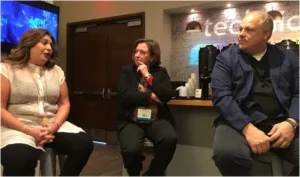Technicolor organized a special media session with three of its top executives to discuss the nascent AR, VR and mixed reality markets. Participating were Technicolor Experience Center head Marcie Jastrow (left photo), group chief technology officer Cristina Gomila (center), and group SVP/CTO home division Jon Walkenhorst (right).
The Technicolor Experience Center, announced last year, is opening in Culver City, California, June 15, and is designed to solve many of the challenges facing immersive entertainment experiences. Jastrow says the idea of the Technicolor Experience Center is “to create content on site, iterate and then deliver it.” “We want to find the tools within the workflow to understand the end-to-end solution,” she said.
At the close of NAB, Technicolor also announced that MPC VR, a Technicolor company, in partnership with Twentieth Century Fox, FoxNext VR, RSA VR, Mach1, AMD Radeon and Dell, announced the release of it latest VR project: Alien: Covenant In Utero. It will be available on the Oculus platform, ahead of the theatrical release of ALIEN: COVENANT on May 10. So far, Technicolor has had a hand in 18 other VR projects.
One clear theme was the need to continue industry collaboration and cooperation to develop the technologies, content and standards to move these technologies along. “The technology is still pretty rough, and delivering these experiences to headsets is not easy. Workflows are not fully there yet,” said Jastrow. “We need industry-wide collaboration,” said Gomila. “We have to make sure everyone contributes to ensure interoperability and a seamless experience over many different devices.”
But the business model needs to develop as well. “If these experiences don’t get into peoples’ possession in some way, in an economical and affordable fashion, we’re going to have a difficult time creating an ecosystem that creates revenue opportunities for the entire value chain,” commented Lane Cooper, Technicolor VP of corporate communication.
“One of the frustrations is the absence of an ecosystem for the experiences to be consumed in the home,” said Gomila. “We have absurd economic value propositions today: content that’s expensive and requires expensive hardware.”
Mixed reality is the next step beyond AR and VR, noted Gomila, which she defined as “when you really embed digital objects into the real world and they become natural.” Achieving that, she said, is “our most long-term challenge,” conceding it’s not something that is going to be finalized overnight because there are technical challenges that still need to be solved.
“Immersive is more than just headsets,” Gomila went on to say. For one thing, to make immersive content a true social experience, it’s important that users see the same things that their friends are seeing at the same time, she said. Here, latency is going to have to be low for a good experience.
“Delivery of high quality VR content is not easy,” noted Walkenhorst. “VR content takes a lot of bandwidth and we need to figure out ways to deliver these services on older networks as well.” One of the ways Technicolor hopes to address this challenge is to try to push computing and process further out toward the network edge. They are now working with AWS on a project called GreenGrass that is designed to optimize some unused compute near the edge. In addition, he said, “Technicolor is at the forefront of ATSC 3.0, looking at fixed wireless broadband, and also working with chip manufacturers to deliver 5G. – CC

